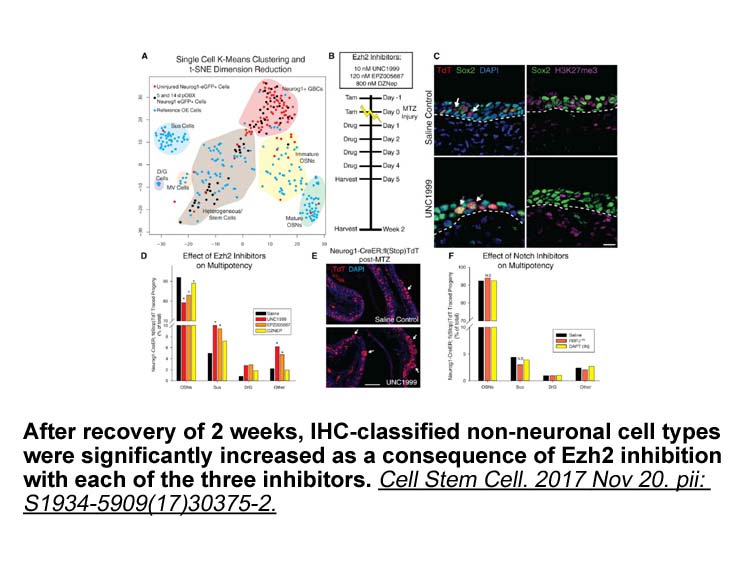Archives
- 2025-12
- 2025-11
- 2025-10
- 2025-09
- 2025-03
- 2025-02
- 2025-01
- 2024-12
- 2024-11
- 2024-10
- 2024-09
- 2024-08
- 2024-07
- 2024-06
- 2024-05
- 2024-04
- 2024-03
- 2024-02
- 2024-01
- 2023-12
- 2023-11
- 2023-10
- 2023-09
- 2023-08
- 2023-07
- 2023-06
- 2023-05
- 2023-04
- 2023-03
- 2023-02
- 2023-01
- 2022-12
- 2022-11
- 2022-10
- 2022-09
- 2022-08
- 2022-07
- 2022-06
- 2022-05
- 2022-04
- 2022-03
- 2022-02
- 2022-01
- 2021-12
- 2021-11
- 2021-10
- 2021-09
- 2021-08
- 2021-07
- 2021-06
- 2021-05
- 2021-04
- 2021-03
- 2021-02
- 2021-01
- 2020-12
- 2020-11
- 2020-10
- 2020-09
- 2020-08
- 2020-07
- 2020-06
- 2020-05
- 2020-04
- 2020-03
- 2020-02
- 2020-01
- 2019-12
- 2019-11
- 2019-10
- 2019-09
- 2019-08
- 2018-07
-
br Collagens as new drivers
2019-11-25

Collagens as new drivers of zebrafish tissue regeneration Contrary to mammals, zebrafish possess very high regeneration capacities and thereby represent a versatile model to study tissue and organ regeneration. Adult fish can fully reconstruct their brain, spinal cord, retina, kidney, liver, panc
-
Through the process of alternative splicing the IKZF
2019-11-25

Through the process of alternative splicing, the IKZF1 gene is capable of encoding a large number of Ikaros isoforms (Molnar et al., 1996). Some of these isoforms were shown to have distinct functions (Li et al., 2011, Ronni et al., 2007). Ikaros protein contains four zinc fingers at the N-terminus
-
br Conclusion and future perspectives
2019-11-25

Conclusion and future perspectives LDL cholesterol-lowering therapy is essential for cardiovascular risk reduction. On the background of a high inter-personal variation of cholesterol synthesis and cholesterol apomorphine the efficacy of cholesterol lowering, both, with statins and with ezetimib
-
Table summarizes the literature data available on the
2019-11-25

Table 4 summarizes the literature data available on the occurrence of these two Pentylenetetrazole synthesis of steroidal compounds in sludge and sediments. In activated and digested sewage sludge, the concentrations of ethynyl estradiol (17 ng/g), estrone (37 ng/g ), and estradiol (49 ng/g) found
-
GW5074 Mammalian cells contain significant amounts of a rela
2019-11-25

Mammalian cells contain significant amounts of a relatively lesser known enzyme that shows marked specifity for ether lipids containing AA and other 20–22 carbon fatty acids. This enzyme is called CoA-independent transacylase (CoA-IT), and transfers polyunsaturated moieties of 20–22 carbons, typical
-
Since ET was discovered first and showed a wide variety
2019-11-25

Since ET-1 was discovered first and showed a wide variety of actions not only on the cardiovascular system but also on various other tissues, much information has accumulated on ET-1 compared with the two other peptides. The method for measurement of ET-1 levels in plasma or various tissues by means
-
Gene chip is a detection technique that can detect
2019-11-25

Gene chip is a detection technique that can detect all the time-point differentially expressed genes (DEGs) information within the same sample. However, due to sample heterogeneity or different sequencing platform, the results for the expressed mRNAs are inconsistent with different gene profile. The
-
N-Methyl-D-aspartic acid The inhibition of mRFP Ub E formati
2019-11-25

The inhibition of mRFP-Ub–E1 formation by ginsenosides Re was not in time-dependent in vitro (Fig. 4B). Fifty micrometres ginsenoside Rg1 decreased E1 activity to 0.24- to 0.36-fold over 30min. This finding suggests that ginsenoside Rg1 may irreversibly inhibit mRFP-Ub–E1 formation or a tight-bindin
-
To study the role of DNA
2019-11-25

To study the role of DNA–PK in the response to replication arrest, we used the DNA replication inhibitor aphidicolin (APH). APH, a mycotoxin isolated from Cephalosporium aphidicola, inhibits DNA replication by interacting with the replicating DNA polymerase α (pol α). APH specifically inhibits the a
-
br The role of TNFs and AD The TNF superfamily
2019-11-25

The role of TNFs and AD The TNF superfamily includes 19 members that can bind 29 different receptors [56, 57]; the 19 members are Lta, TNF-α, lymphotoxin-β (LTβ), OX40L, TNF associated activation protein (TRAP, also named CD40L or gp39), factor associated suicide ligand (FasL), CD70, CD153, 4-1BB
-
br The LSCP model and its properties
2019-11-25

The LSCP model and its properties In this section, we first introduce the LSCP model in Section 2.1. Some examples of the model are presented in Section 2.2 and basic properties of the model are presented in Section 2.3. Finally, Section 2.4 introduces finite dimensional approximations necessary
-
Meanwhile high levels of extraversion have been associated
2019-11-25

Meanwhile, high levels of extraversion have been associated with weaker conditioning and faster MOG (35-55) learning (Eysenck, 1970). Similar to neuroticism/anxiety, the role of extraversion for fear conditioning and extinction has found only limited empirical support (Rauch et al., 2005) with seve
-
br Introduction Oral contraceptives OCs are the
2019-11-25

Introduction Oral contraceptives (OCs) are the most commonly used medication for contraception all over the world and are also used in the treatment of menstrual disturbances and hyperandrogenism in women with polycystic ovary syndrome [1]. The impact of OC steroids on cardiovascular pathophysiol
-
br Methods br Results br Discussion There are two
2019-11-25

Methods Results Discussion There are two particularly important facets of the present ERK findings relevant to drug conditioning. One is the strong ERK signal observed in the medial prefrontal cortex and the nucleus accumbens during the immediate post-trial interval following the final cond
-
br Alcohol and the amygdala br
2019-11-22

Alcohol and the amygdala Alcohol and the CRF1 system Given the marked effects of alcohol on inhibitory neurotransmission in the amygdala and the regulation of amygdalar GABAergic activity by CRF and activity at the CRF1 receptor, the CRF system is a logical site for the actions of alcohol in t
14579 records 931/972 page Previous Next First page 上5页 931932933934935 下5页 Last page